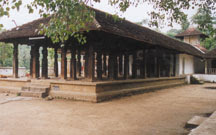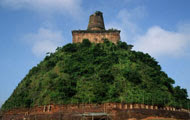Treasure trove of wood carvings - the famous devale.
Embekke Devale, famed for its elaborate woodcarvings, pillars and other structures, nestle in the Udu Nuwara. It lies close to Daulagala about eight miles from Kandy.
Enticing Wood carvings - The UNESCO has identified these marvellous but elaborate carvings on wooden pillars to be the finest products of woodcarvings to be found in any part of the world.
Many are the hoary legends that tell of the origins of this splendid devale. According to archaic documents and the epic Embekke Varnanawa composed by Delgahagoda Mudiyanse, it was built during the Gampola period of King Wickrema Bahu II (1371 AD). One of his consorts named Henakanda Biso Bandara, in association with a drummer named as Rangama, as told in a miraculous dream, is supposed to have built this Devale dedicated to God Kataragama in a superb three-storeyed building which is now no more.
devale. According to archaic documents and the epic Embekke Varnanawa composed by Delgahagoda Mudiyanse, it was built during the Gampola period of King Wickrema Bahu II (1371 AD). One of his consorts named Henakanda Biso Bandara, in association with a drummer named as Rangama, as told in a miraculous dream, is supposed to have built this Devale dedicated to God Kataragama in a superb three-storeyed building which is now no more.
The devale is in two segmented buildings, the Digge (Dancing Hall) and Drummers Hall (Hewasi Mandappaya). Among them that caught my fascination are the following ones.
Embekke Devale, famed for its elaborate woodcarvings, pillars and other structures, nestle in the Udu Nuwara. It lies close to Daulagala about eight miles from Kandy.
Enticing Wood carvings - The UNESCO has identified these marvellous but elaborate carvings on wooden pillars to be the finest products of woodcarvings to be found in any part of the world.
Many are the hoary legends that tell of the origins of this splendid
 devale. According to archaic documents and the epic Embekke Varnanawa composed by Delgahagoda Mudiyanse, it was built during the Gampola period of King Wickrema Bahu II (1371 AD). One of his consorts named Henakanda Biso Bandara, in association with a drummer named as Rangama, as told in a miraculous dream, is supposed to have built this Devale dedicated to God Kataragama in a superb three-storeyed building which is now no more.
devale. According to archaic documents and the epic Embekke Varnanawa composed by Delgahagoda Mudiyanse, it was built during the Gampola period of King Wickrema Bahu II (1371 AD). One of his consorts named Henakanda Biso Bandara, in association with a drummer named as Rangama, as told in a miraculous dream, is supposed to have built this Devale dedicated to God Kataragama in a superb three-storeyed building which is now no more.The devale is in two segmented buildings, the Digge (Dancing Hall) and Drummers Hall (Hewasi Mandappaya). Among them that caught my fascination are the following ones.
The woo den capital pillars have assumed varied shapes moulded skilfully into these intricate wood carvings. The bottom square is octagonal with carvings, while its top terminates in a leaf emanating from square.
den capital pillars have assumed varied shapes moulded skilfully into these intricate wood carvings. The bottom square is octagonal with carvings, while its top terminates in a leaf emanating from square.
Enticing woodcarvings are also carved on some beams, rafters, doorways, and doors as well. Among the best masterpieces on the capital pillars are thus: Hansa Puttuwa (entwined swans) double headed eagles, and entwined rope designs, mother breast-feeding child, soldier fighting on horseback, female dancing figures, wrestlers, women emanating from a vein, bird with human figure, combination of elephant-bull and combination of elephant-lion.
 den capital pillars have assumed varied shapes moulded skilfully into these intricate wood carvings. The bottom square is octagonal with carvings, while its top terminates in a leaf emanating from square.
den capital pillars have assumed varied shapes moulded skilfully into these intricate wood carvings. The bottom square is octagonal with carvings, while its top terminates in a leaf emanating from square.Enticing woodcarvings are also carved on some beams, rafters, doorways, and doors as well. Among the best masterpieces on the capital pillars are thus: Hansa Puttuwa (entwined swans) double headed eagles, and entwined rope designs, mother breast-feeding child, soldier fighting on horseback, female dancing figures, wrestlers, women emanating from a vein, bird with human figure, combination of elephant-bull and combination of elephant-lion.
Among such wonderful carvings, what attracted me most was the elephant-bull carving and that of the elephant with its elongated trunk which is mystically manifested. When one covers with one's palm, the figure of the carving resembling part bull, the real figure of the elephant with elongated trunk is manifested, while when one does the same with that of the elephant there emerges like magic the figure of the bull!
The roof of the Embekke Devale bears some ingenuous revelations of classic carpentry masterpieces in fixing the rafters. The 'Madol Kurupuwa' is one of
 the finest examples of medieval carpentry excellence. It is a wooden pin (this Madol Kurupuwa) which holds together 26 rafters at the hipped end of the roof of the Digge of Embekke Devale.
the finest examples of medieval carpentry excellence. It is a wooden pin (this Madol Kurupuwa) which holds together 26 rafters at the hipped end of the roof of the Digge of Embekke Devale. The giant pin is carved with pathuruliya, patha motifs.
Among the carvings, there are 125 series of decorations, 256 liyawel, 64 lotus designs in Pekada, 30 decorative patterns on timber, roof members, making a total of 514 such exquisite carvings.
All's well with the Embekke Devale, except the fact that the parapet wall facing the road unwanted posters have been pasted which is a real eye-sore to the visiting tourists, particularly to foreigners. The caretakers should be alert to prevent such unwarranted posters being pasted on the wall, which would mar this historic site.
















































